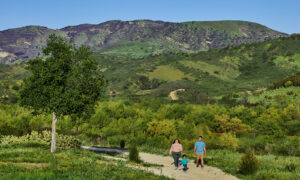Despite what some suggest, Southern California does have seasons. They are governed by a Mediterranean climate that gives us a dry period and a wet period within a calendar year. Fall occurs within the dry period. Temperatures cool a bit, and daylight hours continue to shorten.
Some foliage shifts in color, and some wildlife shifts in movement. Southern California definitely has a fall season; it’s just more subtle compared with other places.
Spot these subtle fall changes:
 PRICKLY PEAR
PRICKLY PEAR
During late summer and fall, prickly pear cactus bears fruit that turns red as it ripens. Wildlife savor both the seeds and sweet, pulpy flesh. Deer, rabbits and rodents manage to nibble on the fruit while avoiding tiny spines (glochids) that can lodge in the skin.
 SYCAMORE
SYCAMORE
By now, the leaves of California sycamores have turned golden brown. Seed clusters emerge, resembling a string of balls. The leaves won’t drop for several weeks. When they do, clusters of mistletoe are revealed.
 PRAYING MANTID
PRAYING MANTID
In September, the egg sacs of California mantids show up on stems and twigs, as well as fences and walls. Watch for this brown or green insect, especially at night near a porch light. Since the light attracts other insects, this carnivore has a steady supply of food.










